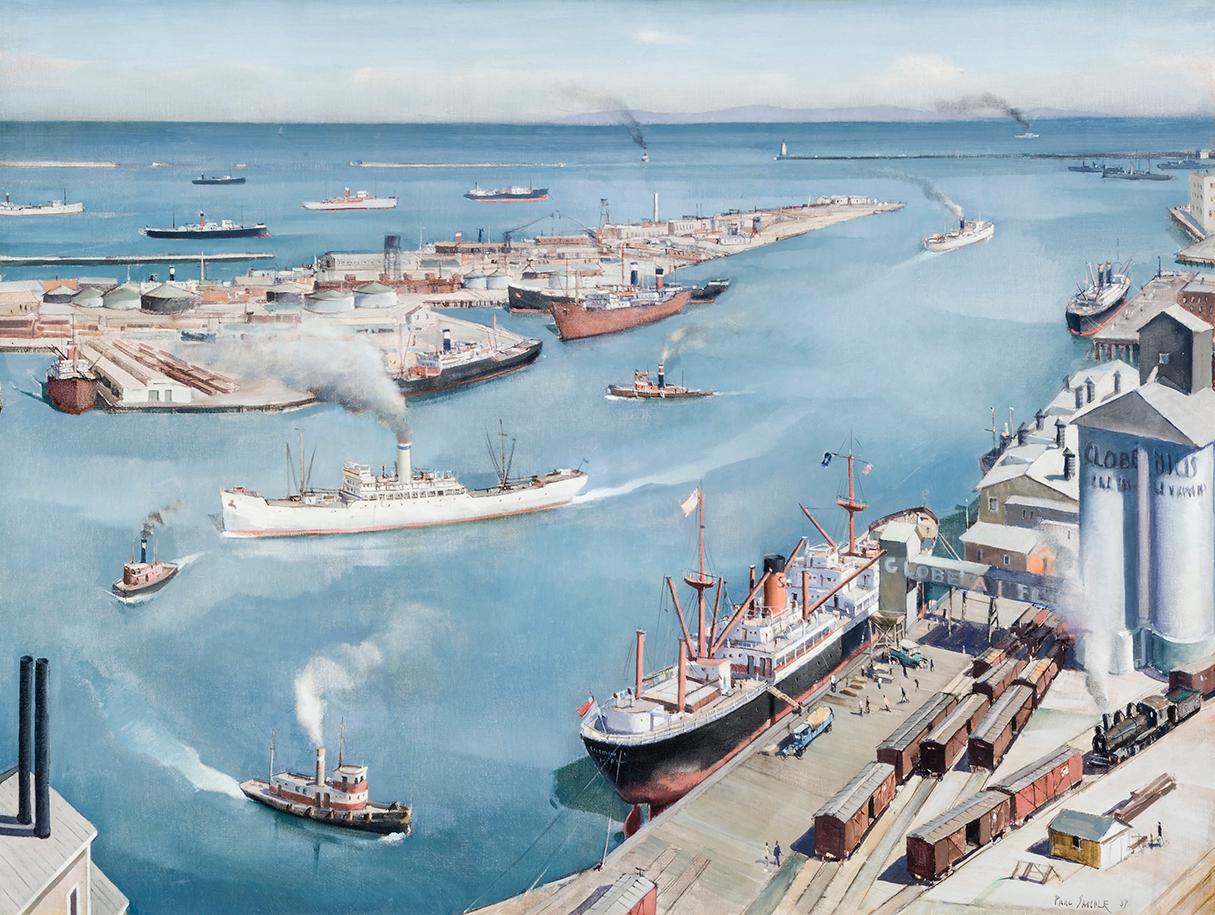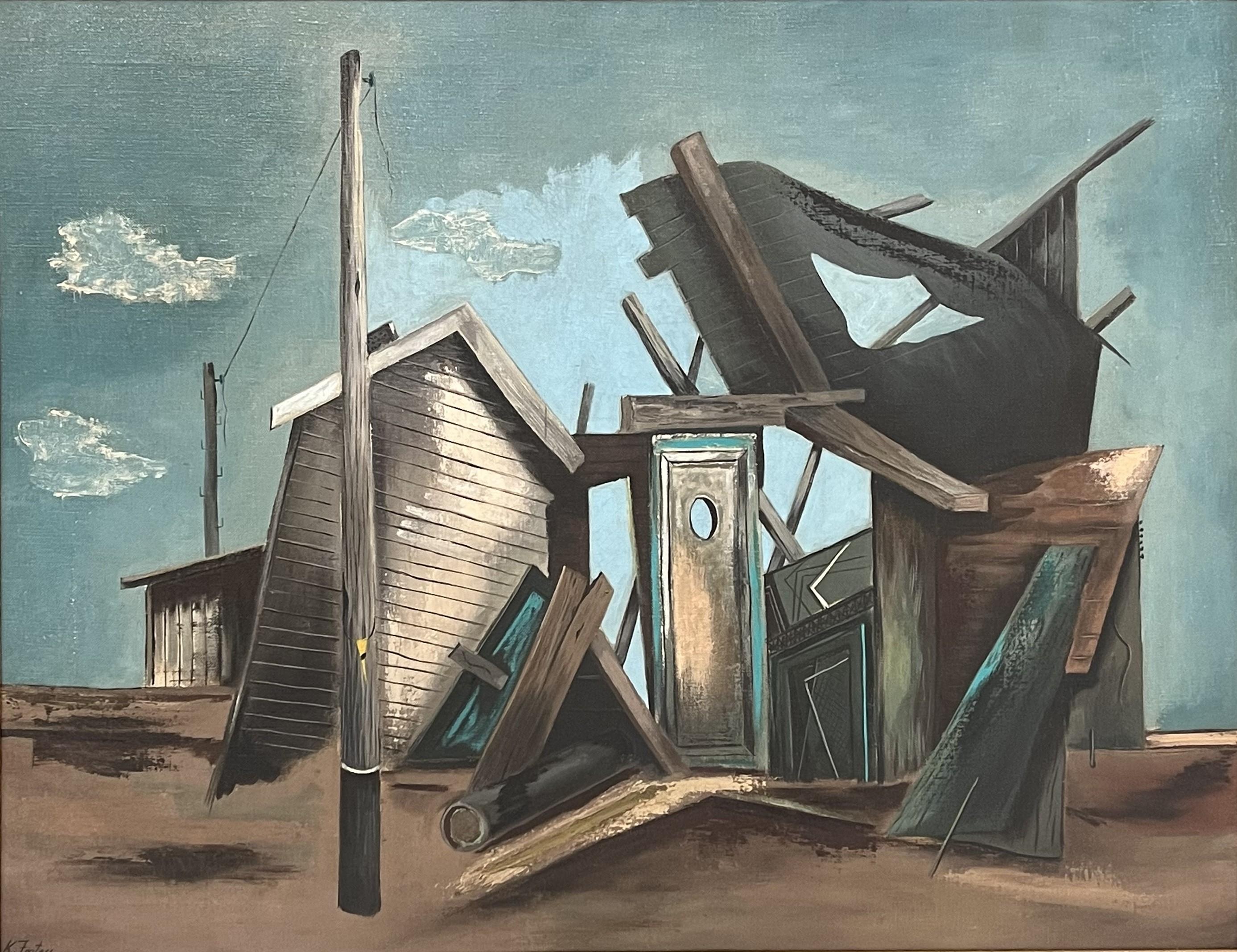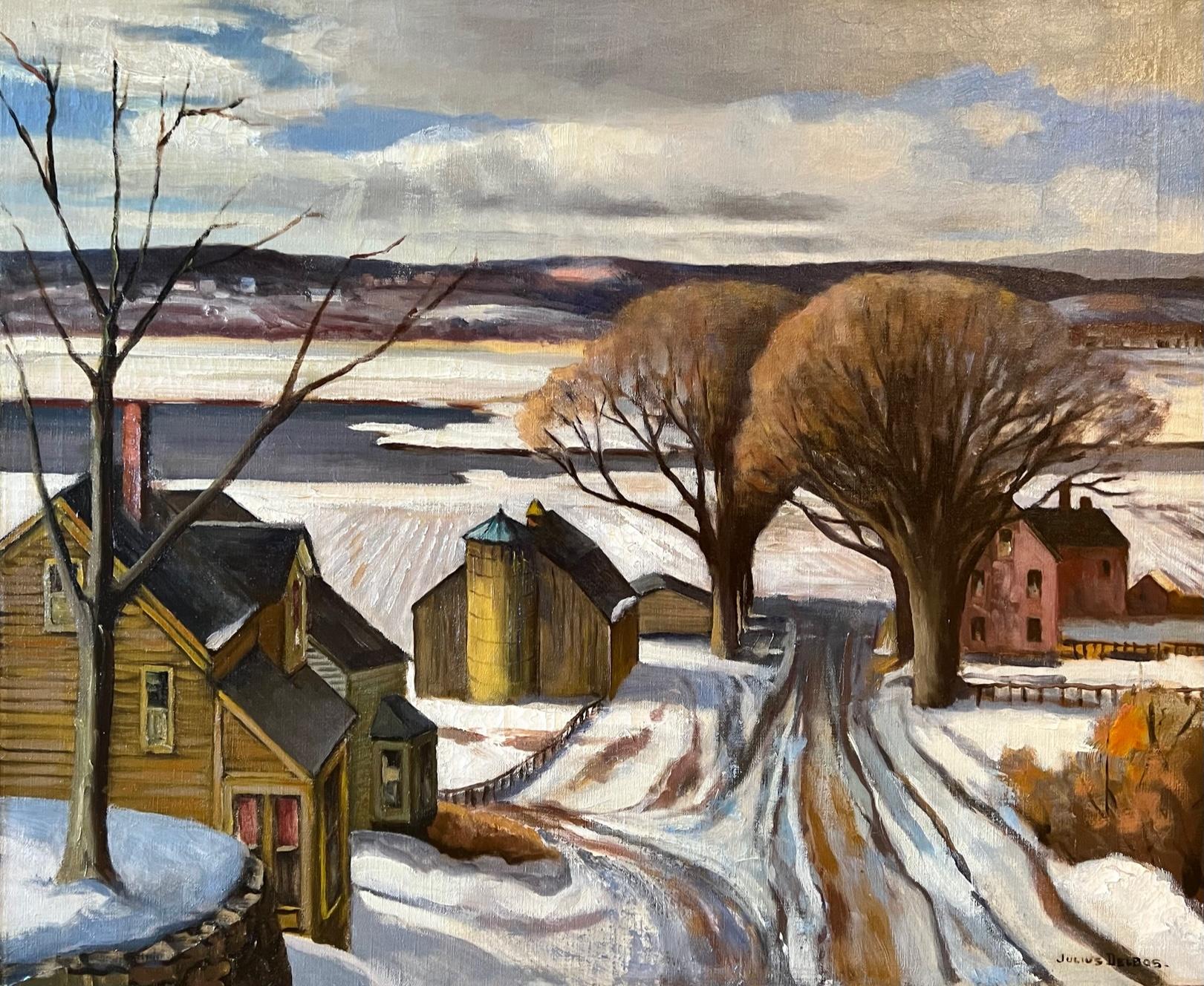William SandersonAbandoned (Colorado) - Oil on Canvas, American Modern Landscape Painting
About the Item
- Creator:William Sanderson (1905-1990)
- Dimensions:Height: 13.25 in (33.66 cm)Width: 16.5 in (41.91 cm)Depth: 0.75 in (1.91 cm)
- Medium:
- Movement & Style:
- Period:
- Framing:Frame IncludedFraming Options Available
- Condition:
- Gallery Location:Denver, CO
- Reference Number:
William Sanderson
William Sanderson, born in Dubbeln, Latvia, emigrated to the United States at the age of eighteen. He settled first in New York City where he studied at the National Academy of Design and the Art Students League. Following his studies, Sanderson worked as a book and magazine illustrator. His work appeared in several popular publications including The New Yorker, Esquire and The New Masses. In 1937, Sanderson was honored with a solo exhibition held at the Contemporary American Artist Gallery in New York City. After World War II, Sanderson relocated to Denver where he was hired by Vance Kirkland to instruct in advertising design at the University of Denver. He remained with the University from 1946 until 1972. In Colorado, Sanderson became active in the artist community, co-founding the Denver based organization known as the Fifteen Colorado Artists. Sanderson painted in a variety of styles, including Cubism, Social Realism and Hard-Edge Abstraction. His work often depicts architecture, ships, nature and the common man. In 1977, Sanderson donated a collection of forty paintings to Northeastern Junior College in Sterling, Colorado. The paintings remain on permanent display at the college in a gallery bearing his name.
- ShippingRetrieving quote...Ships From: Denver, CO
- Return PolicyA return for this item may be initiated within 7 days of delivery.
- Colorado Mine, 1940s WPA Modern Mountain Landscape Oil Painting, 18 x 24 inchesBy Paul Kauvar SmithLocated in Denver, COColorado landscape with an old mine building, trestle, mountains and dark stormy sky, vintage circa 1940 oil painting on canvas by Denver modernist, Paul K. Smith. Painted in colors ...Category
1940s American Modern Landscape Paintings
MaterialsOil, Canvas
- Adobe Church, New Mexico, 1940s Modernist Southwestern Landscape Oil PaintingBy Paul Kauvar SmithLocated in Denver, COVintage 1930s - 1940s oil painting of an adobe church in New Mexico with a brilliant blue sky and clouds (likely Rancho de Taos), circa 1940. Painted by Denver modernist, Paul K...Category
1940s American Modern Landscape Paintings
MaterialsCanvas, Oil
- Native American Figures at Taos Pueblo, New Mexico Southwestern Oil PaintingLocated in Denver, COOriginal 20th century oil painting by Wolfgang Pogzeba (1936-1982) with Native American figures standing in bright blankets with adobe buildings in th...Category
Mid-20th Century American Modern Figurative Paintings
MaterialsOil, Canvas
- Colorado Mountain Summer Landscape, 1930s Framed Modernist Oil PaintingBy Arnold BlanchLocated in Denver, COVintage Modernist WPA era painting by Arnold Blanch (1896-1968) of a Colorado Landscape, likely near Colorado Springs, Colorado, with green fields, red rocks and mountains in the background under a moody sky. Dominant colors include, green, yellow, red/brown, gray, white and blue. Painting is clean and in good vintage condition - please contact us for a detailed condition report. About the Artist: Arnold Blanch was an illustrator, printmaker, teacher and painter. He was primarily known for his landscape, genre, figurative, realist, and surrealist paintings. Born in Manterville, Minnesota, he was encouraged to study art by his mother, an amateur artist. He began studying at the Minneapolis Art Institute in 1914. In 1916, he received a scholarship to study in New York at the Art Students League. In New York, he studied under Robert Henri, Francis Luis Mora, Boardman Robinson, John Sloan, and Kenneth Hayes Miller. In 1919, Blanch arrived in Woodstock, New York to study at the Art Students League summer school. He married his fellow student Lucile Lundquist, and they settled in Woodstock in 1922 after traveling to France for a year. Blanch remained in Woodstock for more than forty years, until his death. He was an important figure in the Woodstock Artists Association, as he devoted much of his time to maintaining financial and moral support for the Association. Throughout his life, Blanch had more than sixty solo and group exhibits. He was awarded the Guggenheim Foundation Fellowship in 1940. In 1962, he had a retrospective at the Krasner Gallery in New York. Blanch's artistic style changed frequently throughout his career. After the 1930's, Blanch's palette became lighter and his subjects became less serious. In the 1930s, after he and his first wife separated, Blanch became romantically involved with artist Doris Lee, and both were influenced by each other's artistic styles for the next thirty years. Blanch was also influenced by the Abstract Expressionists; however, he primarily remained a figurative painter. His last artistic style consisted of shallow pictoral space and tightly arranged structures. ©David Cook Galleries...Category
1930s American Modern Landscape Paintings
MaterialsCanvas, Oil
- Central City, Colorado, 1950s Modernist Cityscape Oil Painting with BuildingsLocated in Denver, COOil on canvas modernist city scape painted circa 1950 by Paul K Smith (1893-1977) titled Central City, Colorado. Portrays a city scene of historic buildin...Category
1950s American Modern Landscape Paintings
MaterialsCanvas, Oil
- View From the Park (Colorado) Mountain View Oil Landscape PaintingBy Charles Ragland BunnellLocated in Denver, COOil on canvas painting by Charles Ragland Bunnell (1987-1968) titled 'View from the Park'. Presented in a custom frame measuring 28 ¾ x 32 ¾ inches; image size is 22 ½ x 26 inches. ...Category
Mid-20th Century American Modern Landscape Paintings
MaterialsCanvas, Oil
- San Pedro HarborBy Paul SampleLocated in New York, NYIt is infrequent, to say the least, that a diagnosis of tuberculosis proves fortuitous, but that was the event, in 1921, that set Paul Starrett Sample on the road to becoming a professional artist. (The best source for an overview of Sample’s life and oeuvre remains Paul Sample: Painter of the American Scene, exhib. cat., [Hanover, New Hampshire: Hood Museum of Art, 1988] with a detailed and definitive chronology by Sample scholar, Paula F. Glick, and an essay by Robert L. McGrath. It is the source for this essay unless otherwise indicated.) Sample, born in Louisville, Kentucky, in 1896 to a construction engineer and his wife, spent his childhood moving with his family to the various locations that his father’s work took them. By 1911, the family had landed in Glencoe, Illinois, settling long enough for Paul to graduate from New Trier High School in 1916. Sample enrolled at Dartmouth College, in Hanover, New Hampshire, where his interests were anything but academic. His enthusiasms included the football and basketball teams, boxing, pledging at a fraternity, and learning to play the saxophone. After the United States entered World War I, Sample, to his family’s dismay, signed on for the Naval Reserve, leading directly to a hiatus from Dartmouth. In 1918 and 1919, Sample served in the U.S. Merchant Marine where he earned a third mate’s license and seriously contemplated life as a sailor. Acceding to parental pressure, he returned to Dartmouth, graduating in 1921. Sample’s undergraduate life revolved around sports and a jazz band he formed with his brother, Donald, two years younger and also a Dartmouth student. In November 1933, Sample summarized his life in a letter he wrote introducing himself to Frederick Newlin Price, founder of Ferargil Galleries, who would become his New York art dealer. The artist characterized his undergraduate years as spent “wasting my time intensively.” He told Price that that “I took an art appreciation course and slept thru it every day” (Ferargil Galleries Records, circa 1900–63, Archives of American Art, Smithsonian Institution, available on line). In 1920, Donald Sample contracted tuberculosis. He went for treatment to the world-famous Trudeau Sanitorium at Saranac Lake, in New York State’s Adirondack Mountains for the prescribed regimen of rest, healthful food, and fresh air. Visiting his brother in 1921, Paul also contracted the disease. Tuberculosis is highly contagious, and had no certain cure before the development of streptomycin in 1946. Even for patients who appeared to have recovered, there was a significant rate of recurrence. Thus, in his letter to Price, Sample avoided the stigma conjured by naming the disease, but wrote “I had a relapse with a bad lung and spent the next four years hospitalized in Saranac Lake.” The stringent physical restrictions imposed by adherence to “the cure” required Sample to cultivate an alternate set of interests. He read voraciously and, at the suggestion of his physician, contacted the husband of a fellow patient for instruction in art. That artist, then living in Saranac, was Jonas Lie (1880–1940), a prominent Norwegian-American painter and an associate academician at the National Academy of Design. Lie had gained renown for his dramatic 1913 series of paintings documenting the construction of the Panama Canal (The Metropolitan Museum of Art, New York; United States Military Academy, West Point, New York). Primarily a landscape artist, Lie had a particular affinity for scenes with water. His paintings, impressionistic, atmospheric, and brushy, never strayed from a realistic rendering of his subject. Sample regarded Lie as a mentor and retained a lifelong reverence for his teacher. Sample’s early paintings very much reflect Lie’s influence. ` In 1925, “cured,” Sample left Saranac Lake for what proved to be a brief stay in New York City, where his veteran’s benefits financed a commercial art course. The family, however, had moved to California, in the futile hope that the climate would benefit Donald. Sample joined them and after Donald’s death, remained in California, taking classes at the Otis Art Institute in Los Angeles. In Sample’s account to Price, “I couldn’t stomach the practice of painting a lot of High Sierras and desert flowers which seemed to be the only kind of pictures that were sold here so I got a job teaching drawing and painting at the art school of the University of Southern California.” Initially hired as a part-time instructor, Sample progressed to full-time status and ultimately, by the mid-1930s, to the post of Chairman of the Fine Art Department. Sample, however, did not want to wind up as a professor. “Teaching is all right in small doses,” he wrote, “but I have a horror of drifting into being a college professor and nothing more.” At the same time as he taught, Sample began to exhibit his work in a variety of venues at first locally, then nationally. Though he confessed himself “a terrible salesman,” and though occupied with continued learning and teaching, Sample was nonetheless, ambitious. In 1927, he wrote in his diary, “I am eventually going to be a painter and a damned good one. And what is more, I am going to make money at it” (as quoted by Glick, p. 15). In 1928, Sample felt sufficiently solvent to marry his long-time love, Sylvia Howland, who had also been a patient at Saranac Lake. The Howland family were rooted New Englanders and in summertime the Samples regularly traveled East for family reunion vacations. While the 1930s brought serious hardship to many artists, for Paul Sample it was a decade of success. Buttressed by the financial safety net of his teacher’s salary, he painted realist depictions of the American scene. While his work addressed depression-era conditions with a sympathetic eye, Sample avoided the anger and tinge of bitterness that characterized much contemporary realist art. Beginning in 1930, Sample began to exhibit regularly in juried exhibitions at important national venues, garnering prizes along the way. In 1930, Inner Harbor won an honorable mention in the Annual Exhibition of the Art Institute of Chicago. That same year Sample was also represented in a show at the Albright-Knox Gallery in Buffalo and at the Biennial Exhibition of the Corcoran Gallery of Art, Washington, D.C. In 1931, Dairy Ranch won the second Hallgarten Prize at the Annual Exhibition of the National Academy of Design, in New York. Sample also made his first appearances at the Carnegie Institute, Pittsburgh, and The Pennsylvania Academy of the Fine Arts, Philadelphia. In 1936, Miner’s Resting won the Temple Gold Medal at the Pennsylvania Academy’s Annual Exhibition. Always interested in watercolor, in 1936, Sample began to send works on paper to exhibitions at the Whitney Museum, New York. While participating in juried exhibitions, Sample also cultivated commercial possibilities. His first New York art dealer was the prestigious Macbeth Gallery in New York, which included his work in a November 1931 exhibition. In 1934, Sample joined the Ferargil Galleries in New York, after Fred Price arranged the sale of Sample’s Church Supper to the Michele and Donald D’Amour Museum of Fine Arts in Springfield, Massachusetts. In 1937, The Metropolitan Museum of Art purchased Sample’s Janitor’s Holiday from the annual exhibition of the National Academy of Design, a notable honor. As prestigious as this exhibition schedule may have been, by far Sample’s most visible presence in the 1930s and 1940s was the result of his relationship with Henry Luce’s burgeoning publishing empire, Time, Inc. Sample’s first contribution to a Luce publication appears to have been another San Pedro...Category
20th Century American Modern Landscape Paintings
MaterialsCanvas, Oil
- The Old Monastery WallBy William S. SchwartzLocated in New York, NYSigned (at lower left): WILLIAM S. SCHWARTZCategory
Early 20th Century American Modern Landscape Paintings
MaterialsCanvas, Oil
- LandscapeBy Marcel Emile CaillietLocated in Los Angeles, CALandscape, 1940, oil on canvas, 24 x 20 inches, signed, dated and titled verso: “Marcel Cailliet ’40 – S.C.” and “Marcel Cailliet Landscape”; likely exhibited at the annual juried st...Category
1940s American Modern Paintings
MaterialsCanvas, Oil
- Untitled (Collapsed Shacks)By Karl FortressLocated in Los Angeles, CAUntitled (Collapsed Shacks), c. 1940s, oil on canvas, signed lower left, 20 ½ x 26 ½ inches, presented in a period frame This work is part of our exhibition America Coast to Coast: ...Category
1940s American Modern Paintings
MaterialsCanvas, Oil
- Untitled (Farm in Winter)By Julius M. DelbosLocated in Los Angeles, CAThis work is part of our exhibition America Coast to Coast: Artists of the 1940s Untitled (Farm in Winter), 1940s, oil on canvas, signed lower right, 26 x 30 inches, presented in an original frame Julius Delbos...Category
1940s American Modern Paintings
MaterialsCanvas, Oil
- 1927 Oil Painting Eiffel Tower Paris American Modernist Wpa Artist Morris KantorBy Morris KantorLocated in Surfside, FLMorris Kantor New York (1896 - 1974) Paris from the Ile St. Louis, 1927 (view of Eiffel Tower) Oil painting on canvas Hand Signed lower left. Provenance: Hirshhorn Museum and Sculpture Garden, Smithsonian Institution ( bears label verso) Size: 20 3/4"H x 28 1/8"W (sight), 28.75 "H x 36"W (framed) Morris Kantor (Belarusian: Морыс Кантор) (1896-1974) was a Russian Empire-born American painter based in the New York City area. Born in Minsk on April 15, 1896, Kantor was brought to the United States in 1906 at age 10, in order to join his father who had previously relocated to the states. He made his home in West Nyack, New York for much of his life, and died there in 1974. He produced a prolific and diverse body of work, much of it in the form of paintings, which is distinguished by its stylistic variety over his long career. Perhaps his most widely recognized work is the iconic painting "Baseball At Night", which depicts an early night baseball game played under artificial electric light. Although he is best known for his paintings executed in a realistic manner, over the course of his life he also spent time working in styles such as Cubism and Futurism, and produced a number of abstract or non-figural works. A famous cubist, Futurist, painting of his "Orchestra" brought over 500,000$ at Christie's auction house in 2018 Kantor found employment in the Garment District upon his arrival in New York City, and was not able to begin formal art studies until 1916, when he began courses at the now-defunct Independent School of Art. He studied landscape painting with Homer Boss (1882-1956). In 1928, after returning to New York City from a year in Paris, Kantor developed a style in which he combined Realism with Fantasy, often taking the streets of New York as his subject matter. He did some moody Surrealist Nude paintings and fantasy scenes. In the 1940's he turned towards figural studies. Later in his career, Kantor himself was an instructor at the Cooper Union and also at the Art Students League of New York in the 1940s, and taught many pupils who later became famous artists in their own right, such as Knox Martin, Robert Rauschenberg, Sigmund Abeles and Susan Weil...Category
1920s American Modern Landscape Paintings
MaterialsCanvas, Oil






